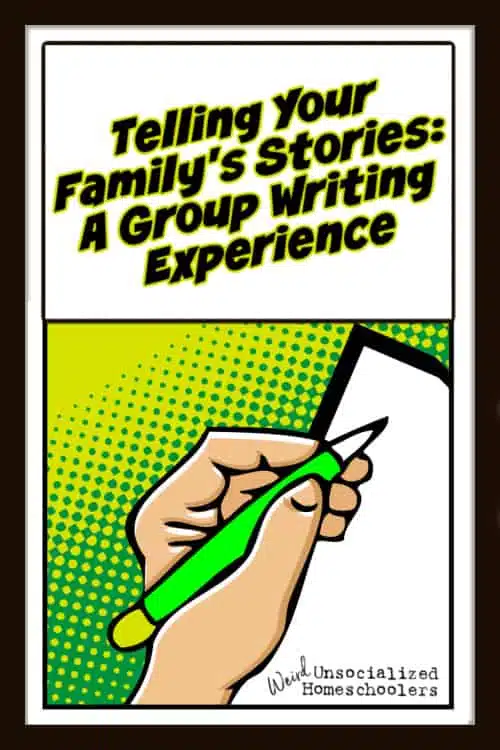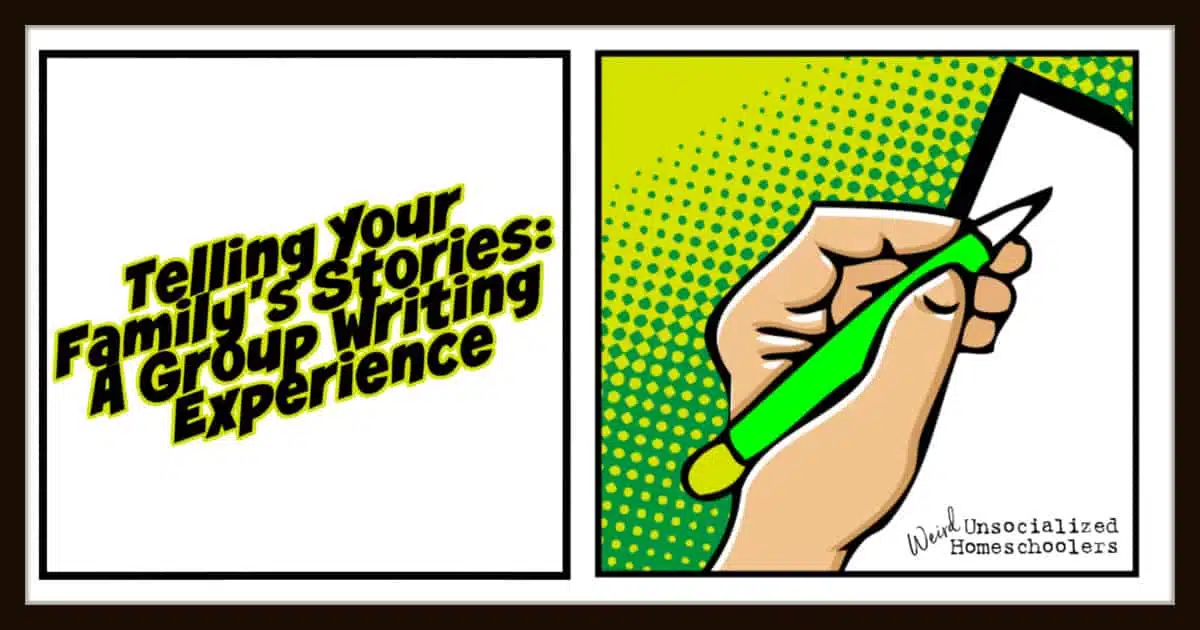Telling Your Family’s Stories: A Group Writing Experience
Telling Your Family’s Stories: A Group Writing Experience
Our family has a language arts project this year – a group project, where we’re all contributing. I’m loving it, the kids are loving it, we’re learning a lot, and we’re building our family’s identity.
We’re telling stories. Our stories. Little snippets of everyday life, exciting moments, about challenging and even scary times. And we’re writing them together.
The idea came this summer. We were sitting around the dinner table, and I was trying to tell a story from our family’s history, one I’d heard as a child and wanted to pass on to my family. I wanted to tell the story, but I got stuck on the details. Exactly who was involved, what the setup was, why in the world mashed potatoes got flung, and if it was a bowl or a spoon… I had forgotten.
We texted my parents for the details, but as we kept talking, I realized that we were building our own family’s story book, and we should write these stories down before they became vague memories, and so, our project began.
Step 1: Planning What Stories to Tell
The next day, the kids and I sat around and brainstormed. What stories did we have to tell? The ideas kept flowing, and I typed them all in a Google doc, because, let’s get real, I’ll lose them if they’re on paper. I encouraged them to tell specific stories, events, moments in time, rather than longer time frames, so they chose:
- When we discovered and rescued a noisy cricket
- A beach discovery
- When I ate the spiciest pulled pork ever
- A tooth that refused to come out
- Going on a walk and getting caught in the rain
- Losing power in a tropical storm
and more stories, personal stories, snapshots of significance in our everyday lives. We brainstormed for a while, and then we put the list away for the day.
Step 2: Taking Turns Telling Stories
Because my kids are younger, and because I want this to be a group writing exercise, I typed and generally guided the writing process. We started one afternoon a few days later, and every child got to choose a story to tell. That child was the main storyteller, but everyone was allowed to contribute. I guided the telling with prompts for background, details, responses, and context, steering the telling but not taking over.
Who was there? Where were you? What was going on?
Why did he say that? What happened next? What were you thinking at that point?
Hold on — something else important happened then. What else do we need to know?
There was excitement as we told our tales – contributing what they remembered, sharing their voices and reactions.
Step 3: Read-Alouds and Images
An important part of this process is the kids hearing their words read back to them, having a chance to affirm or change what has been recorded, and going back through and finding pictures that either showed the event, the aftermath of the event, or how old the kids were at the time. Together we listened and edited the story and found a photo before moving on to the next. We did this for each child, and then we stopped for the day.
Step 4: Adding and Sharing
These stories are all of ours, so we continue to brainstorm and add to our “to be told” list. We’ve repeated this process three times in the last month, and now we have nine stories that have been recorded. We’re not done, but when we are, we plan on making a book, whether a 3-ring binder that can be added to, or a printable photo book (like Shutterfly) that can chronicle and immortalize our memories.
The important thing is that we’re giving our kids a voice in their own stories, helping them rehearse, as a unit, how we have helped each other, worked together, overcome obstacles, and grown as a family. For those of you for whom faith plays an important role in your family, this is a great place to add details about prayer, about support from the church, and about how God was at work in your family’s story. A brief note of caution – in those cases, we still need the child’s voice to come through rather than imposing our perspective on how faith played a role.
It’s an exciting process seeing your words and ideas in print, knowing that they become part of a shared history. As we raise the next generation, as we seek to help them grow and develop their skills as well as their relationships, this storytelling can be a valuable tool in that process, and we can even learn surprising things about our kids in the process – how they think, how they process these events, and what’s important to them, which can make our relationships even stronger.
I encourage you to give this a try! It doesn’t have to be a long overwhelming experience. Do a little each day (or each week) to make it a manageable process. But do it. You truly will be glad you did, and it truly is worth the investment of time and effort. You’ll always treasure the time you spent with your children recording your family’s stories, and these stories will become a life-long treasure for your children.
Heather Pleier is a 2nd generation homeschooler raising three curious, creative, out-of-the-box kids on Long Island. They are eclectic game/interest-led/unschooly homeschoolers who dive deep into various interests and celebrate the freedom that homeschooling brings. Her passions include great children’s literature, dark chocolate, exploration, and music. She writes at wonderschooling.net about preserving childhood wonder and curiosity.







